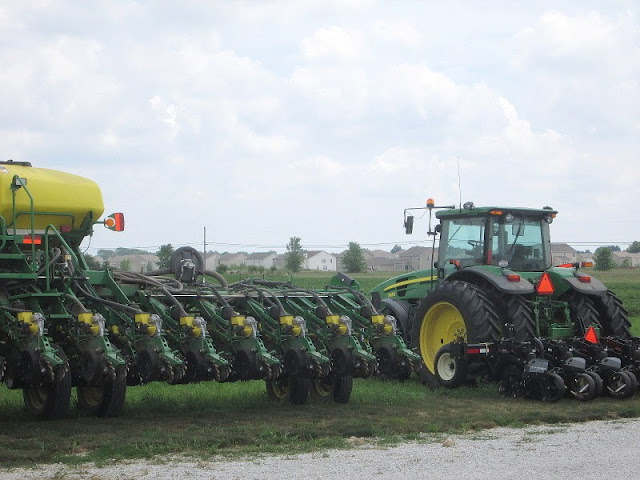So today I was in Brownsburg, IN for the Cover Crop & Nutrient Management Field Day hosted by Area Manager Mike Starkey. The Hendricks County Soil and Water Conservation District was the co-host. Brownsburg is right next to Indianapolis. It was attended by around 50 area growers who are all seeking ways to best farm ground close to urban developments. This would include the use of cover crops and no-till. I used to live in the Indianapolis area and it was sure a contrast to see corn growing so close to the city. The Starkeys have been farming here for six generations, and are very conscious about using responsible cropping management practices.
One of the featured guests was Barry Fisher who is Indiana's Soil Health Specialist. He is well known and evidently has spent more time down in soil pits than up on the ground. Here he is in a pit in a soybean field that had a cover crop of cereal rye. It was flown on prior to corn harvest last year. Well last year this area was hard hit by drought. This left a lot of unused nitrogen in the soil, and it was utilized by the rye, which was up to four feet tall prior to planting. You can see a thick clump on the side. But there is a good stand of soybeans this year.
He was able to show that the soil was loose from about 7 years of no-till with cover crops. He also was able to find ample evidence of earth worms, and showed a string of soybean root nodules up to 16 inches deep, that evidently grew down a worm tunnel. (They are those knobs on the root to the left of his face.) Nodulation this deep would provide oxygen for organic matter decomposition and better soil health. (Note: if you don't know, certain soil bacteria called Rhizobia japonicum form a symbiotic relationship with soybean roots where the bacteria provides nitrogen to the soybean and the soybean provides a place for the bacteria to live. The bacteria form nodules which are the "factories" where the bacteria convert nitrogen from the air, which the soybeans can't use, into a form that they can use. Everybody wins.)
We also looked at a pit that had annual rye as a cover crop. It wasn't as thick and tall as the cereal rye. But rye is a cover crop to prevent soil erosion and to "scavenge" soil nutrients and then release them back after they are killed prior to planting. Plus they can add organic matter and keep the soil more biologically active. This is a view of some nice beans from the pit sites looking back to Mike's shop where we were meeting. The beans look great this year.
Here is a view from Mike's shop. It was suburban Indianapolis where they also grow sub-divisions. So farming responsibly is very important. There were also some folks that talked about equipment and which closing wheels work best for the soils and no-till around here. And there was a guy from the Natural Resources Conservation Service (NRCS) who described a watershed program that Mike is going to participate in to compare fertilizer practices in adjacent sides of a creek that drains into a nearby reservoir. It will compare a Liquid program vs a conventional program and will be monitored for drainage tile nutrient loss, soil nutrient levels, erosion losses, and yield. Details to follow. This is brand new.
To pay for the free lunch, they had to listen to me talk about the products that Mike is using on his farm with great success. Mike said that many growers were not aware of things like phosphate fixation and crop nutrient demands, so I did my best to lay it out, plus how research at the NCRS supports conservation and nutrient management practices.
Everyone else paid attention and hopefully learned some things. But there were a few in the audience whose brains got filled up too fast and nodded off. Fortunately it was only SAM Adam and Regional Sales Mgr Bob, who have heard it all before anyway. At least they didn't snore.
After that Mike came up to follow up on what he does with AgroLiquid and to have some Q&A.
Mike also is a Dawn Equipment dealer. And the last thing was a brand new prototype fresh from Dawn Equipment. In fact it was just painted at the factory in Illinois last night and driven over this morning. It is a planter attachment for planting into a standing rye cover crop. The disks go in front of the row and bend the rye over, and then the rolling blades flatten and crimp the rye. This would be able to kill smaller rye, but larger rye, like 4 feet tall, would still have to be sprayed. But this would enable easier planting. So this meeting was the first in the solar system to see it. Everyone likes to look at equipment.
So after that I headed back North to Michigan. Tomorrow will be a very busy day on the farm as the Research Field Days start next week. And here is a heads up for next Monday night. Make sure to tune in to RFD Live on the RFD TV channel at 8 pm EDT. You will see some of your favorite researchers Live From the NCRS. (Hey that has a nice ring to it.) So if you don't have Dish or Direct TV, then find someone who does and be there next Monday.








